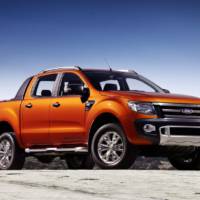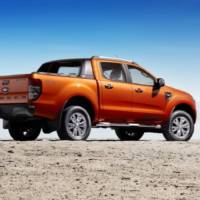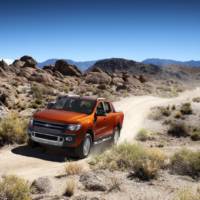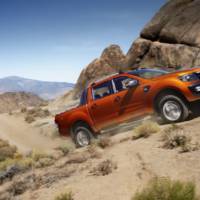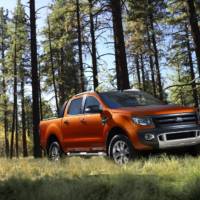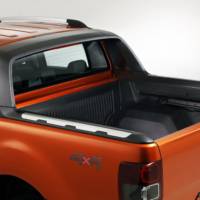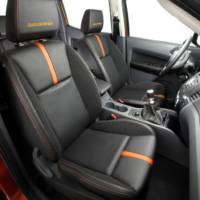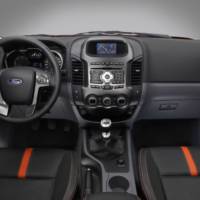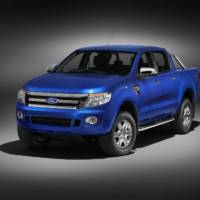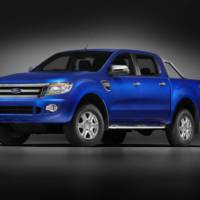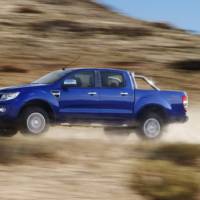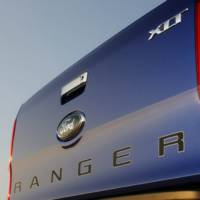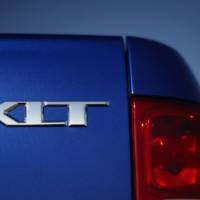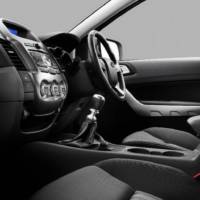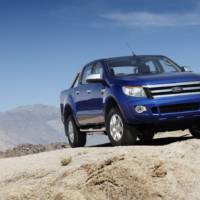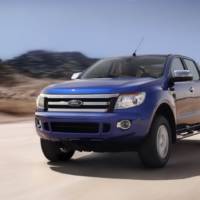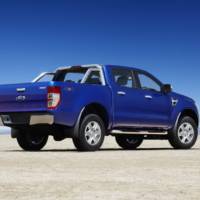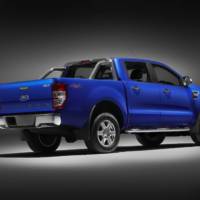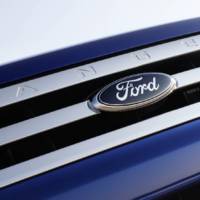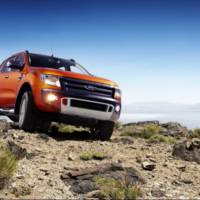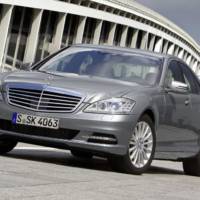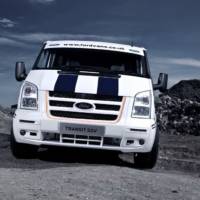The Blue Oval has released details regarding the European spec models 2012 Ford Ranger, as the automaker’s new pickup has made its appearance at the 2011 Commercial Vehicle Show in Birmingham ,UK.
The 2012 Ranger will be sold on more than 180 world markets, and in Europe it will be available in three cab styles (Single Cab, RAP/Rear Access Panel Cab and Double Cab), two drivetrain options (4×2 and 4×4), two ride heights and up to five standard versions to choose from, which include the Wildtrak model.
In terms of motorisation, European customers will be able to fit their 2012 Ford Ranger with either a 2.2-litre Duratorq TDCi developing 150 PS and 375 Nm of torque or a 3.2-litre producing 200 PS and 470 Nm, both units available with either manual or automatic 6-speed transmissions.
The 150 PS 4×2 version promises to return 37.2 mpg (UK rating) / 7.6-litres per 100 Km while the 200 PS variant will range from 33.6 mpg (8.4-litres/100Km) on the 4×2 to 29.4 mpg (9.6-litres/100 Km) on the full option 4×4 version.
Some of the Ranger’s strong points include a towing capacity of up to 3350 Kg, and a payload of 1333 Kg on the diesel models, while in terms of safety and equipment the 2012 Ford Ranger comes with new side curtain airbags, thorax protecting front-seat side airbags, and features like voice operated Bluetooth and a Rear View Camera system.
For complete details on the European spec versions 2012 Ford Ranger check out the official press release below.
Ford press release :
* All-new Ford Ranger pick-up takes the stage at the 2011 Commercial Vehicle Show in Birmingham, UK, ahead of sales launch later in the year
* New from the ground up, the Ranger delivers its traditional ruggedness combined with increased loading capability, improved performance and economy, enhanced comfort and safety, smarter technology and a tough new look
* Powerful new Ford Duratorq TDCi diesel engines with responsive six-speed transmissions deliver strong, refined performance and outstanding fuel economy
* Class-leading towing capability of up to 3,350kg, increased load box volume, and a payload capacity of up to 1,333kg prove that the Ford Ranger heritage of toughness is still going strong
* Outstanding customer choice with three versatile cab styles, the option of 4×2 and 4×4 drivetrains, and up to five different series including the stunning Wildtrak model
* Enhanced safety performance with new side curtain airbags for head protection and thorax-protecting front-seat side airbags as standard across all cab styles in Europe
* Packed with desirable features and smart technologies such as Bluetooth®with Voice Control and Rear View Camera system
BIRMINGHAM UK, Apr. 12, 2011– The exciting all-new
Ford Ranger pick-up enters the stage on the Ford stand at the Commercial
Vehicle Show in Birmingham, UK, ahead of its European sales launch
later in 2011.
New from the ground up – with everything changed except its name –the
Ranger has been engineered to combine the model’s traditional strength
and durability with increased loading capability, improved performance
and economy, enhanced comfort and safety, smarter technology and a tough
new look.
The all-new Ranger is the first commercial vehicle to be built under
the One Ford strategy as part of a global product programme, bringing
together the full engineering expertise of Ford around the world.
Developed in Australia, it will be produced in Thailand, South Africa
and Argentina for sale in more than 180 markets worldwide.
Outstanding range of versatile, capable pick-ups
New Ranger will be offered as a complete family of pick-up models
with a choice of three versatile cab body styles – Single Cab, RAP (Rear
Access Panel) Cab and Double Cab – along with the option of 4×2 and 4×4
drivetrains, two ride heights and up to five series choices to suit
every pocket and market.
European customers will have a choice of two new state-of-the-art
Ford Duratorq TDCi diesels which deliver improved power, torque and fuel
efficiency: 2.2-litre (150PS and
375Nm) and 3.2-litre (200PS and 470Nm).
Building on Ranger’s long-standing reputation for strength and
dependability, the all-new model offers an outstanding depth of
capability. A larger load box offers increased carrying volume with all
cab styles; generous towing capacity ranging up to a best-in-class 3350
kg; and models with the 2.2-litre diesel have an outstanding payload
capacity of up to 1333 kg.
Improved comfort, technology and safety
The all-new Ford Ranger is just as much at home on a leisure trip as
it is delivering goods to a construction site, and the new model
redefines the level of comfort, technology and safety that customers can
expect from a hard-working pick-up.
A completely redesigned cabin offers generous space and superb
craftsmanship, and is packed with the kind of smart technologies which
are more commonly found on contemporary passenger cars. These range from
features like satellite navigation, Bluetooth®connectivity and voice
control, to the Rear View Camera System with a display integrated in the
rear view mirror which is unique in the pick-up class.
With its incredibly strong high-strength steel passenger cell
structure and advanced restraint systems – including new side curtain
airbags and thorax-protecting front-seat side airbags fitted as standard
across all cab styles in Europe – the all-new Ranger has been
engineered to deliver class-leading safety performance.
The new model also utilises a whole suite of technologies to enhance
active safety, including features like Hill Launch Assist, Hill Descent
Control, and a carefully tuned Electronic Stability Program (ESP) system
to help the vehicle keep its wheels sturdily planted on the road under
all conditions.
Built tough, for total dependability
Built to last, the all-new Ranger has undergone one of the toughest
development and testing regimes ever undertaken for a vehicle of this
type.
Tested in Australia, Dubai, Thailand, North America, South America,
Sweden and South Africa, it had to face severe heat and cold, monsoon
rains, high altitudes as well as rushing rivers, arid deserts and
potholed roads. Prototypes clocked more than a million kilometres on the
road, supported by countless hours of exhaustive testing in
laboratories.
Combine this hard-earned dependability with the new model’s
impressive fuel economy, and the Ranger offers European customers a
highly competitive package with attractive lifetime ownership values.
"Since it was introduced to Europe in 1997, the Ford Ranger has
established itself as a major player in the European pick-up segment,"
said Jesus Alonso, Ford of Europe’s director for Commercial Vehicle
Marketing, Sales and Service. "This all-new model will reinforce the
reputation of the Ranger brand with its bold new appearance, improved
depth of capability for hard working businesses, and new levels of
comfort, technology and safety. And with a significantly improved fuel
economy this new vehicle offers both low cost of ownership and
sustainability benefits. We are starting a new chapter in the Ranger
success story."
21st Century Tough styling
The all-new Ranger is immediately recognisable from its bold new exterior style, which its designers have named ‘21st Century Tough’.
Toned, taut and muscular, the new Ranger is designed to look powerful
and confident, equally at home in an industrial estate or outside a
high-class restaurant. Its front end features a short overhang with the
signature three-bar grille, a global Ford commercial vehicle design cue.
The windscreen has been raked back for a sportier and more dynamic
silhouette, while the traditional square form of the truck has been
sculpted to give the vehicle a more modern and aerodynamic look. Larger
headlamps, bigger mirrors and stamped-in wheel lips provide an
integrated look across all series and contribute to an aggressive and
sporty stance.
Designers also raised the beltline significantly, along with the
rails of the load box, giving the Ranger a substantive presence on the
road while increasing its functionality with the deeper box.At 5,359mm
long and 1,850mm wide, the new model is 279mm longer and 62mm wider than
the outgoing model, benefitting both interior space and load capacity.
Dynamic new Wildtrak
For customers seeking a ruggedly stylish and supremely functional
lifestyle vehicle, the Wildtrak version takes Ranger’s sporty appearance
even further, with a unique colour split on the front.
Designers masked out the feature line on the front fascia and
contrasted it by highlighting the lower intake. The same dark accent
colours were used on the side mirrors, door handles and side air vents
to give the vehicle a dynamic sporty look.
“Wildtrak’s aggressive look and bold new graphics are a perfect fit
for those who appreciate a sporty and more expressive image. It will
look fantastic transporting the latest quad bike or jet ski for weekend
getaways”, said Craig Metros, chief designer of the all-new Ranger.
Sitting high on 18-in alloy wheels, the Wildtrak also comes with a
roof rack and a sports hoop which enhance its profile. Exclusive
Wildtrak badging and graphics help to set it apart from other lifestyle
vehicles.
Three spacious and versatile cabs
Ford’s new global truck will be offered in a choice of three cab body
styles – Single Cab, RAP Cab and Double Cab – to suit the diverse needs
of pick-up customers. All three cab styles are among the roomiest in
the segment.
The two-door Single Cab is a two-seater that provides exceptional
load space. For additional storage and space to seat four people, the
innovative RAP Cab – first introduced on the Ranger in 2002 – has a
unique four-door system that provides unobstructed access to the cabin
via two forward-hinged doors and two rear-hinged access panels. The
four-door Double Cab has plenty of room for five adults, providing
flexibility for both leisure and business.
Engineers have optimised every millimetre of Ranger’s dimensions to
give maximum interior space without compromising the volume of the cargo
box. With Ranger increasingly being a work-and-family vehicle, the
engineers have paid special attention to the rear seats in the truck,
with the second row in the RAP Cab more spacious than key competitors.
The B-pillar in the Double Cab has been moved forward, delivering
best-in-class rear leg room and knee clearance. Three adults can easily
fit in the second row of the Double Cab while two six-footers can
comfortably sit one behind the other.
Outstanding cargo capacity
In terms of space for loads, the deeper load box and increased length
and width of the all-new Ranger have resulted in outstanding cargo
capacity. The Single Cab and the RAP Cab have the biggest box volume in
its class at 1.82 cubic metres and 1.45 cubic metres respectively while
the Double Cab is among the top with 1.21 cubic metres.
For example, the cargo box of the new Double Cab is more than 100mm
wider than before – 1,549mm long by 511mm high and with a maximum cargo
width of 1,560mm.
Width between the wheel arches is 1,139mm on all models and special
provisions are provided in the cargo box to place timber inserts in
pockets that are located above the wheel arch. This allows plywood or
sheet rock to be stacked flat. Width at the rear tailgate opening, at
the top of the box, is 1,330mm.
A flexible cargo management system is available where attachment
points can be moved along a rail, instead of fixed points on the body,
so customers have greater choice when tying down a load.
All-new Ranger can also haul exceptionally heavy loads, with a towing
capacity ranging up to a best-in-class 3,350kg, and an outstanding
payload capacity of up to 1,333kg on models with the 2.2-litre diesel
engine.
Car-like interior comfort
With a completely new interior design, the Ranger offers a
contemporary look and feel with features and comfort normally found only
in passenger cars. The bold graphics of the interior surfaces are
finished with materials that will stand up to the demands of a workhorse
while delivering a lasting quality appearance.
From the no-fuss vinyl seats of the base series to the cloth trim and
leather option of the higher series, all materials used in the new
Ranger were subjected to heavy-duty testing for commercial vehicle use.
“We’ve developed materials that are tough, not rough, which will
deliver a quality appearance matched by high performance,” said interior
design manager Peter Jones. “So, for example, you get passenger car
comfort in the design and trim of the seats with commercial vehicle
durability to withstand a whole range of rigorous usage.”
The dynamic Wildtrak model features unique materials and finishes,
including seat trim inspired by sportswear which combines leather and
woven cloth. Contrast stitching and a discreet strip on the seat upper
and bolster, all in distinctive Wildtrak Orange, accentuate the premium
feel of the interior.
Making full use of the spacious interior, the Ranger Double Cab
offers 23 storage spaces in the cabin – more practical stowage than any
competitor. Its deep centre console bin is the biggest in its class at
8.5 litres and can keep up to six cans of beverage cool in models with a
duct from the air-conditioner.
The glove box is large enough to accommodate a 16-in laptop computer
while door pockets can comfortably fit 1.5-litre water bottles. Ample
storage for mobile phones and other small items can be found in the
console and in areas within easy reach of the driver. Underneath the
rear seats, a convenient hidden storage area for tools can easily be
accessed.
Loaded with smart technology
Poised to be a leader in innovation, the all-new Ranger comes loaded
with smart technologies that make the pick-up easier, safer and more fun
to drive.
Selected models offer Bluetooth® audio streaming, USB and iPod
connectivity, together with voice control over the radio, CD, iPod, USB,
air-conditioning and mobile phone (with software that recognises
English, Spanish, French, German, Italian, Portuguese and Turkish).
Dual-zone climate control and cruise control are available on the high
series while selected models offer a five-inch colour screen with
satellite navigation.
The Ranger is also the first vehicle in the segment to offer a Rear
View Camera system. This system which displays the camera image in a
section of the rear view mirror when reverse gear is selected
dramatically improves visibility of objects behind the truck and also
simplifies hooking up a trailer.
Marker lines superimposed on the camera image help drivers reverse
even more safely and accurately, showing the path of the vehicle based
on the current steering angle. Two yellow lines indicate the total width
of the pick-up, along with additional coloured bars that signpost
distances of 0.3 metres, one metre and two metres. A black dotted line
that marks the pick-up’s centre line assists the driver in lining up a
tow hook with a caravan or trailer.
More power, more torque, more economy
Ranger customers in Europe will have a choice of two new
state-of-the-art common-rail Ford Duratorq TDCi diesels which serve up
exceptional performance with more power and torque, while also
delivering outstanding fuel efficiency.
The two new diesel engines feature numerous refinements, including
the implementation of the latest high-pressure common rail fuel
injection systems. The injection systems have been precisely tailored
and calibrated for outstanding combustion efficiency, achieving
excellent fuel economy ratings while meeting the most stringent exhaust
emissions standards.
The 150PS 2.2-litre four-cylinder diesel engine replaces the previous
2.5-litre unit in the Ranger line up, and with a substantial 375Nm of
torque offers over 13 per cent more pulling power. When fitted to a 4×2
model, it consumes as little as 7.6 L/100 km (37.2 mpg)* in the combined
cycle – a reduction in fuel consumption of over 10 per cent compared to
the previous model – making it one of the most fuel-efficient pick-ups
in the segment.
The formidable new 200PS 3.2-litre five-cylinder diesel engine
delivers a stump-pulling 470Nm of torque, over 23 per cent more than the
3.0-litre engine it replaces. Its fuel consumption in a combined cycle
is among the leaders in this area, ranging from 8.4 L/100 km (33.6mpg)*
on a 4×2 variant to 9.6 L/100 km (29.4mpg)* on a full-option 4×4 model.
With a generous 80-litre fuel tank, new Ranger also offers one of the
longest ranges in its segment, with as much as 1,000km (620 miles)
possible between fill-ups.
Advanced new six-speed transmissions
The all-new Ranger breaks new ground by being available with a choice
of advanced new six-speed transmissions, with both manual and automatic
gearboxes being offered.
These new six-speed transmissions offer significant benefits over the
more traditional four and five speed alternatives, delivering increased
fuel economy, greater responsiveness and enhanced refinement.
The new six-speed automatic transmission has been extensively tuned
to deliver smooth, quick shifts that are almost imperceptible to the
driver, reinforcing new Ranger’s car-like refinement. In Normal mode,
the calibration focuses on comfort and fuel economy. For sportier
driving, a quick flick of the shifter changes the transmission to
Performance mode, providing later shift points and giving the driver the
option to select gears manually through a forward (downshift) or
rearward (upshift) movement.
New Ranger also features smart Ford technologies such as Adaptive
Automatic Mode, which adapts gear shifts according to driving style and
Grade Control Logic, which automatically downshifts when driving
downhill and the brake pedal is depressed. This feature prevents the
transmission from changing to a higher gear.
For those who prefer greater involvement, the six-speed manual
transmission with its short, car-like shifter, provides crisp and
precise shifting matched perfectly to the generous torque output of the
new diesels. An upshift indicator in the instrument panel helps drivers
select the best moment to change gear for optimum fuel economy.
Enhanced fuel efficiency
Maximising fuel economy was a key priority for the Ranger engineering
team, and the new truck features a host of measures to eliminate any
waste or inefficiency.
The aerodynamics of the Ranger’s body was rigorously optimised using
cutting-edge simulation technology. Ford’s aerodynamicists performed
more than 1,000 full-vehicle aerodynamic simulations to minimise drag
and deliver the most streamlined shape.
Design refinements introduced to improve efficiency include the
addition of a hard line at the fender top, a more vertical backlight
position, an optimised A-pillar shape and a small spoiler added to the
top of the tailgate. The shape of the front air dam also plays a
significant role in controlling the airflow underneath the vehicle, and
was optimised to achieve a significant reduction in drag.
To make Ranger more efficient than ever, the engineers insisted on
tyres offering the best rolling resistance but without compromising
grip, ride and handling. The gear ratios and final drives were also
meticulously matched to the engines to deliver maximum fuel economy
while ensuring optimal performance, towing capability and payload
capacity.
The powertrains also feature a Smart Regenerative Charging system
which increases the alternator output when the vehicle brakes or
decelerates. This converts the kinetic energy of the vehicle into
electric energy without having to use additional fuel. The ‘free’
electric current is used to recharge the battery, so that it can be used
by the electrical systems at a later stage.
Robust drivetrains for all terrains
Capable of handling even the most challenging topography, the
drivetrains of the all-new Ranger have been extensively tested to ensure
they offer optimum reliability and durability.
Four-wheel-drive models are equipped with a well-proven
electronically controlled transfer box – for both manual and automatic
transmissions – that allows drivers to shift ‘on the fly’ from 4×2 to
4×4 anytime via a switch conveniently located on the console. If extra
torque or additional downhill braking is needed, the driver has the
option of selecting low-range.
A variety of final drive ratios, from 3.31 to 5.3, will be available
depending on the drive configuration and whether the vehicle is a low-
or high-ride model.
Advanced safety protection
Although an independent vehicle safety assessment testing will not
take place until later this year, Ford is forecasting that the all-new
Ranger will be a leader in safety for its segment.
Like all contemporary Ford products, Ranger is engineered to provide
comprehensive safety protection, starting with the highly protective
body structure utilising high-strength steel throughout to protect
occupants in a collision and the all-new frame that manages the brunt of
crash energy.
Engineers used sophisticated computer modelling to go through more
than 9,000 full-vehicle crash simulations before the first prototype
vehicle was subjected to a physical crash test.
Standard on all cab styles in Europe for the first time, side curtain
airbags deploy from the headliner to provide a protective cushion for
the head of occupants in case of a side impact. The curtain is designed
to protect both rows of occupants by covering the upper side structure
and glass from the A-pillar to the C-pillar.
New side airbags also deploy from the side bolster of the front seats
to protect the thorax from side-impact forces, working in tandem with
the front airbags for the driver and front passenger. Knee airbags are
also standard across all models.
Other passive safety technologies include three-point safety belts
for all seating positions, with pre-tensioners and load limiter for the
front seats, as well as Ford BeltMinder technology which helps remind
front-seat occupants to wear their belts.
Enhanced pedestrian safety
On top of the passive safety technologies, the new Ranger has been engineered with the latest pedestrian protection features.
Technologies that emerged from a global Ford research project on
pedestrian-friendly vehicle designs have now been applied to a pick-up
for the first time ever. This includes a “hexageneous” under-bonnet
structure to reduce the potential for pedestrian head injuries, and a
pedestrian-friendly front bumper design incorporating energy-absorbing
materials.
Other new Ranger technologies which aid the driver but can also help
them avoid potential contact with pedestrians include Rear Park Assist
and the advanced Rear View Camera System.
Innovative active safety technologies
The all-new Ranger also uses innovative active safety technologies to
help drivers avoid accidents. A key component is the Electronic
Stability Programme (ESP) which comes with a full suite of features that
make driving the Ranger even safer in both on- and off-road conditions.
The Trailer Sway Control system monitors the behaviour of the tow
vehicle and trailer array to sense the advent of trailer sway and apply
braking countermeasures to reduce its effects. Adaptive Load Control
provides additional stability assurance for drivers dealing with heavy
payloads.
When driving downhill, Hill Descent Control ensures that the brakes
will be applied to control the vehicle at a set speed. Or when stopping
on a steep grade, Hill Launch Assist helps the driver to pull away
confidently without creeping, even when fully laden.
The Ranger’s ESP system includes off-road logic which recognises when
the pick-up is driven on rough roads and modifies the system to ensure
the best balance between stability and timeliness of interventions.
In 4×4 models, the ESP system can be partially switched off to
disable over- and understeer control as well as engine torque
reductions, while maintaining the brake intervention traction control.
This setting is most suitable when driving through deep sand or extreme
mud as vehicle momentum can be maintained whilst maximising available
grip. The ESP can be switched to a second setting to further amend the
ESP braking intervention that aids the initial pull away in snow and icy
conditions.
Powerful braking performance
The all-new Ranger has been engineered with the largest brakes in its
segment, resulting in a system which provides powerful braking
performance with excellent fade resistance, even when driving with
maximum payload.
An array of braking technologies work together to ensure short
stopping distance under all circumstances, such as the Anti-Lock Brake
System (ABS), Emergency Brake Assist and Electronic Brake Force
Distribution which maximises brake force used on the rear wheels as
payload changes while maintaining optimal stability. During emergency
braking, the hazard lights also come on to warn other motorists.
The ABS system features a Gravel Road Logic which further improves stopping distances on loose surfaces such as unsealed roads.
Rugged chassis, ready for all conditions
With an all-new chassis frame, front and rear suspension and steering
system, the new Ranger promises car-like comfort, reduced steering
effort, more precise handling and better on-road stability.
Front and rear suspension designs are entirely new, for a smooth,
firm and comfortable ride whatever the road conditions or the size of
the payload. The front suspension features a coil-over-strut layout,
with carefully optimised designs for the upper and lower wishbones,
while the rear suspension is based on a rugged leaf spring design.
Even on narrow city streets, the pick-up’s tight turning circle makes
it easily manoeuvrable despite sitting on an increased wheelbase. The
responsive rack-and-pinion power steering system requires just 3.5 turns
lock-to-lock, for precise and nimble responses.
The 4×4 Ranger features a higher frame height as standard, although
the 4×2 version can also be specified as a Hi-Rider model which shares
the same frame as the 4×4 model.
Tackling rough terrain
Engineers have found ways to tuck key components out of harm’s way so
that the all-new Ranger can perform on rough terrain. Its ground
clearance of up to 241mm is enhanced by having the driveline components
mounted above the frame rail so that items like the transfer case and
oil pan are protected by strong crossmembers.
To improve Ranger’s water-wading capability, the truck’s key
electrical components and air inlets are strategically placed high in
the engine compartment, enabling the pick-up to go deeper than any
others. The 4×4 and 4×2 Hi-Rider models can wade through up to 800mm of
water – a class-leading feature that will be welcomed by customers who
need to ford rivers or floods.
When the terrain gets really rough and Ranger is in four-wheel drive
low gearing, it provides the driver with more control through the
accelerator pedal, which becomes damped and less sensitive. This
prevents unintentional acceleration due to the bouncing motion of the
driver’s foot while moving over bumpy terrain.
“The all-new Ranger is a very capable and composed vehicle both on-
and off-road,” said Jesus Alonso. “It has been designed as a global
vehicle and combines the best of all worlds – exceptional safety,
outstanding fuel economy, contemporary styling, interior comfort,
cutting edge technologies, and class-leading towing and payload
capabilities – in a one-tonne package that fits in perfectly with the
needs of our customers.”
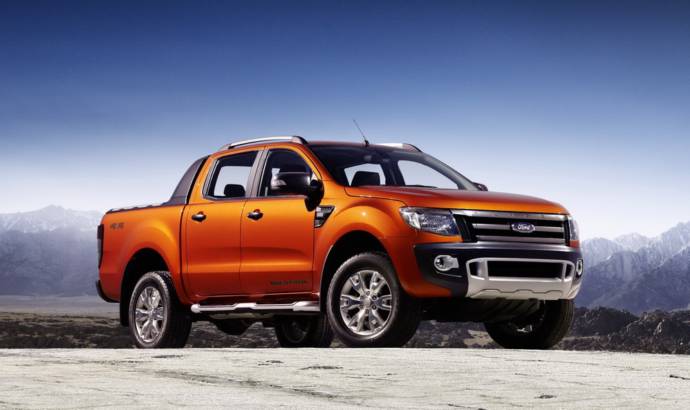
12 Apr 2011
0

